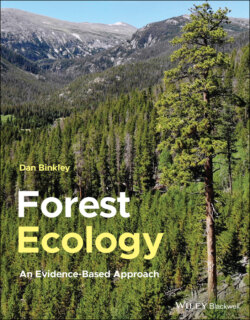Читать книгу Forest Ecology - Dan Binkley - Страница 18
Оглавление
Acknowledgements
It takes a virtual village to write a book, and I want to acknowledge and thank the villagers whose insights shaped this book, and my career. Each of my university advisors contributed new dimensions to thinking about forest ecology. Wally Covington at Northern Arizona University set the stage, and brought out interests in connecting chemistry and ecology. Hamish Kimmins at the University of British Columbia broadened my experiences, and patiently endured my skeptical challenges of so many ideas. Kermit Cromack's curiosity and enthusiasm across a broad range of ecology and science was infectious – and persistent. Ed Packee at MacMillan Bloedel provided the questions, insights, funding and free reign that were so important early in my career. Colleagues and students at Duke University's School of Forestry and Environmental Studies could not have done a better job of sustaining the momentum provided by earlier members of the village. The worldwide community of scientists in forest ecology and forest soils provided collaboration, ideas, and education over the following decades. Some of the most generous villagers were Tom Stohlgren, Mike Ryan, Peter Högberg, Bill Romme, Bob Powers, Dale Johnson, Jose Luiz Stape and Bob Stottlemyer. Most of my career developed at Colorado State University, with world‐class colleagues and students. I cannot conceive of any village that would have been more fun, more supportive, or more productive; this tree acknowledges coauthors across four decades, with font sizes proportional to how many works we wrote together. Thanks to all of you – and to Mason Carter and Jane Higgins for working through and polishing these chapters. There are many ways a forest ecology textbook could be written; this is the one I could write.
